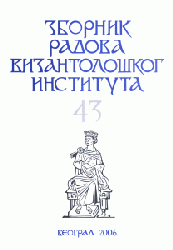Patrijarh Jefrem - jedan poznosrednjovekovni svetiteljski kult
Patriarch Ephrem: A Late Medieval Saintly Cult
Author(s): Danica PopovićSubject(s): History
Published by: Vizantološki institut SANU
Keywords: Patriarch Ephrem; saintly cult; Serbian church;
Summary/Abstract: Patriarch Ephrem, monk and hermit, writer and saint, Bulgarian-born but twice the leader of the Serbian Church (1375-78 and 1389-92), is an outstanding figure of the late medieval Balkans. His "life and works" are discussed here in the light of hagiological texts and the information provided by various types of sources with the view to drawing some historically relevant conclusions. The main source of information about Ephrem's life and activity are the eulogies, Life and service composed by bishop Mark, his disciple and loyal follower for twenty-three years. Making use of hagiographical topica combined with plentiful data of undoubted documentary value, he relates the story of Ephrem's life through all of its major stages: from his birth and youth to his withdrawal from the world and taking of a monk's habit. Of formative influence were his years on the Holy Mount Athos, where he experienced different styles of monastic life, coenobitic, as well as solitary, which he practised in the well-known hermitages in the heights of Athos. The further course of Ephrem's life was decided by the turbulent developments in the Balkans brought about by the Ottoman conquests. In that sense, his biography, full of forced and voluntary resettlements, is a true expression of the spirit of the times. Forced to flee Mount Athos, Ephrem made a short stay in Bulgaria and then, about 1347, came to Serbia, where he spent the rest of his life. An eminent representative of the monastic elite and under the aegis of the Serbian patriarch, he spent ten years in a hesychastria of the Monastery of Decani. For reasons of security, he then moved to a cave hermitage founded specially for him in the vicinity of the Patriarchate of Pec. It was in that cell, where he lived for twenty years powerfully influencing the monastic environment, that his literary work, profoundly marked by hesychast thought and eschatology, was created.
Journal: Зборник радова Византолошког института
- Issue Year: 2006
- Issue No: 43
- Page Range: 111-127
- Page Count: 15
- Language: Serbian

